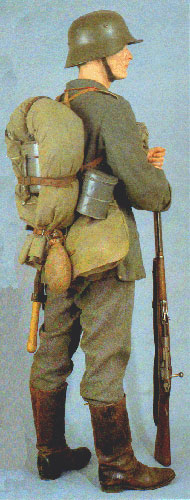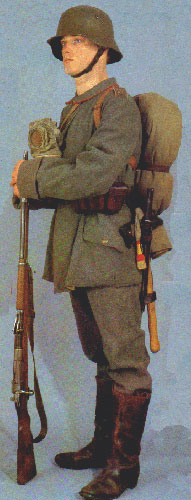|
1. M1916 Stahlhelm (steel helmet), hot-pressed from a hard silicon-nickel steel; more expensive than Allied helmets, which were cold-pressed, it was also heavier (2lb.10½ oz. or 1.2kg), and gave better protection to face, ears and neck. It had an efficient internal sizing system of leather tabs and pads, and used the old M.1891 chinstrap. Two external lugs allowed the fitting, at need, of an extra steel plate shaped to the front of the skull--the Stirnpanzer--for use by sentries and other particularly exposed personnel. Issued with a field grey paint finish, some helmets were later painted in an angular multi-colored camouflage pattern of dull red/browns, ochres, green and blue/greys divided by black lines. Various fabric covers were also used for extra concealment, the most common being of light khaki sandbag material.
2. M.1914 Feldbluse (also called the "Transitional" tunic by collectors); our Soldat has not yet received the M1915 "Bluse"--in fact, all types of tunic including the M1907/10 were still to be seen in use right through to the end of the war. In regulation style, this tunic lacks cuff patches and simulated skirt pocket flaps. The white piping of the shoulder straps was now common to all line infantry; note red `184' chain-stitch embroidered at the ends.
3. M.1915 Gasmaske (gasmask); the Gummimaske, now carried in a grey-painted metal canister which gave better protection than the old bag, but which did not include a spare filter cartridge. The canister was carried on a sling; the mask could be arranged in the "alert" position on the chest.
4. Sturmgepäck (assault pack), consisting of the M.1915 Mantel (greatcoat) rolled in the M.1892 Zeltbahn (tent/shelter-quarter), the ends strapped together, and the roll arranged round the M.1910 Kochgeschirr (mess kit)--here a wartime example in enameled metal painted field grey. The Brotbeutelriemen and several Mantelriemen (greatcoat straps) and Kochgeschirrriemen (messkit straps) allow the pack to be arranged and slung in this manner.
5. M.1887 Brotbeutel (breadbag or haversack), here an ersatz model in grey cloth.
6. The M.1907 Feldflasche (canteen), also of ersatz economy manufacture, in sheet iron enameled in field grey, covered with a coarse cover made of "papercloth". Woven from paper and wool, papercloth was a valuable wartime substitute for cloth and was much more durable than would be believed.
7. The Schanzzeug--this time the M.1887 Beilpicke (pick-hatchet) in its black leather carrier, secured to the scabbard of the ersatz bayonet by a strap.
8. Seitengewehr (bayonet) of wartime ersatz manufacture, its hilt and scabbard of steel painted field grey secured to the entrenching tool handle in the usual way to stop it from flapping and clattering when the soldier was on the move. The Troddel or bayonet knot was still brightly colored like the pre-war type, with one change, the strap was now grey. The various colored sections of the Troddel identified the Kompagnie according to a complex sequence: this combination is that of the 10. Kompagnie.
9. M.1895 Koppel (belt); this and one of the triple M.1909 Patronentaschen (cartridge pouches) has been blackened as ordered in September 1915, the other has not--this kind of mixed equipment was not uncommon under front-line conditions.
10. M.1914 Hosen (trousers) in steingrau (stone grey); wartime-made examples often lacked the regulation red seam piping.
11. M.1886 Marschstiefel (marching boots) in blackened leather.
12. M.1898 Mauser Gewehr 98 (rifle ‘98), in 7.92x57mm caliber; this sling is of ersatz manufacture, of fabric with leather ends.
|





